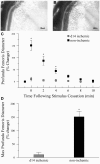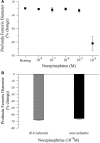Chronic hindlimb ischemia impairs functional vasodilation and vascular reactivity in mouse feed arteries
- PMID: 22164145
- PMCID: PMC3230861
- DOI: 10.3389/fphys.2011.00091
Chronic hindlimb ischemia impairs functional vasodilation and vascular reactivity in mouse feed arteries
Abstract
Vasodilation of lower leg arterioles is impaired in animal models of chronic peripheral ischemia. In addition to arterioles, feed arteries are a critical component of the vascular resistance network, accounting for as much as 50% of the pressure drop across the arterial circulation. Despite the critical importance of feed arteries in blood flow control, the impact of ischemia on feed artery vascular reactivity is unknown. At 14 days following unilateral resection of the femoral-saphenous artery-vein pair, functional vasodilation of the profunda femoris artery was severely impaired, 11 ± 9 versus 152 ± 22%. Although endothelial and smooth muscle-dependent vasodilation were both impaired in ischemic arteries compared to control arteries (Ach: 40 ± 14 versus 81 ± 11%, SNP: 43 ± 12 versus and 85 ± 11%), the responses to acetylcholine and sodium nitroprusside were similar, implicating impaired smooth muscle-dependent vasodilation. Conversely, vasoconstriction responses to norepinephrine were not different between ischemic and control arteries, -68 ± 3 versus -66 ± 3%, indicating that smooth muscle cells were functional following the ischemic insult. Finally, maximal dilation responses to acetylcholine, ex vivo, were significantly impaired in the ischemic artery compared to control, 71 ± 9 versus 97 ± 2%, despite a similar generation of myogenic tone to the same intravascular pressure (80 mmHg). These data indicate that ischemia impairs feed artery vasodilation by impairing the responsiveness of the vascular wall to vasodilating stimuli. Future studies to examine the mechanistic basis for the impact of ischemia on vascular reactivity or treatment strategies to improve vascular reactivity following ischemia could provide the foundation for an alternative therapeutic paradigm for peripheral arterial occlusive disease.
Keywords: chronic ischemia; hindlimb; mouse; reactivity; vasodilation.
Figures




Similar articles
-
Hindlimb unweighting alters endothelium-dependent vasodilation and ecNOS expression in soleus arterioles.J Appl Physiol (1985). 2000 Oct;89(4):1483-90. doi: 10.1152/jappl.2000.89.4.1483. J Appl Physiol (1985). 2000. PMID: 11007586
-
Ischemia-reperfusion impairs ascending vasodilation in feed arteries of hamster skeletal muscle.Microcirculation. 2005 Oct-Nov;12(7):551-61. doi: 10.1080/10739680500253451. Microcirculation. 2005. PMID: 16207628
-
Integration of skeletal muscle resistance arteriolar reactivity for perfusion responses in the metabolic syndrome.Am J Physiol Regul Integr Comp Physiol. 2009 Jun;296(6):R1771-82. doi: 10.1152/ajpregu.00096.2009. Epub 2009 Apr 22. Am J Physiol Regul Integr Comp Physiol. 2009. PMID: 19386988 Free PMC article.
-
Regulation of coronary blood flow during exercise.Physiol Rev. 2008 Jul;88(3):1009-86. doi: 10.1152/physrev.00045.2006. Physiol Rev. 2008. PMID: 18626066 Review.
-
Integration of blood flow control to skeletal muscle: key role of feed arteries.Acta Physiol Scand. 2000 Apr;168(4):511-8. doi: 10.1046/j.1365-201x.2000.00703.x. Acta Physiol Scand. 2000. PMID: 10759588 Review.
Cited by
-
Combined Intravital Microscopy and Contrast-enhanced Ultrasonography of the Mouse Hindlimb to Study Insulin-induced Vasodilation and Muscle Perfusion.J Vis Exp. 2017 Mar 20;(121):54912. doi: 10.3791/54912. J Vis Exp. 2017. PMID: 28362362 Free PMC article.
-
CD146+Mesenchymal stem cells treatment improves vascularization, muscle contraction and VEGF expression, and reduces apoptosis in rat ischemic hind limb.Biochem Pharmacol. 2021 Aug;190:114530. doi: 10.1016/j.bcp.2021.114530. Epub 2021 Apr 21. Biochem Pharmacol. 2021. PMID: 33891966 Free PMC article.
-
Murine spinotrapezius model to assess the impact of arteriolar ligation on microvascular function and remodeling.J Vis Exp. 2013 Mar 3;(73):e50218. doi: 10.3791/50218. J Vis Exp. 2013. PMID: 23486360 Free PMC article.
-
Formation of microvascular networks: role of stromal interactions directing angiogenic growth.Microcirculation. 2014 May;21(4):278-89. doi: 10.1111/micc.12115. Microcirculation. 2014. PMID: 24447042 Free PMC article. Review.
-
Testing the sympathetic nervous system of the foot has a high predictive value for early amputation in patients with diabetes with a neuroischemic ulcer.BMJ Open Diabetes Res Care. 2018 Nov 21;6(1):e000592. doi: 10.1136/bmjdrc-2018-000592. eCollection 2018. BMJ Open Diabetes Res Care. 2018. PMID: 30487975 Free PMC article.
References
-
- Bauters C., Asahara T., Zheng L. P., Takeshita S., Bunting S., Ferrara N., Symes J. F., Isner J. M. (1995). Recovery of disturbed endothelium-dependent flow in the collateral-perfused rabbit ischemic hindlimb after administration of vascular endothelial growth factor. Circulation 91, 2802–2809 - PubMed
Grants and funding
LinkOut - more resources
Full Text Sources

